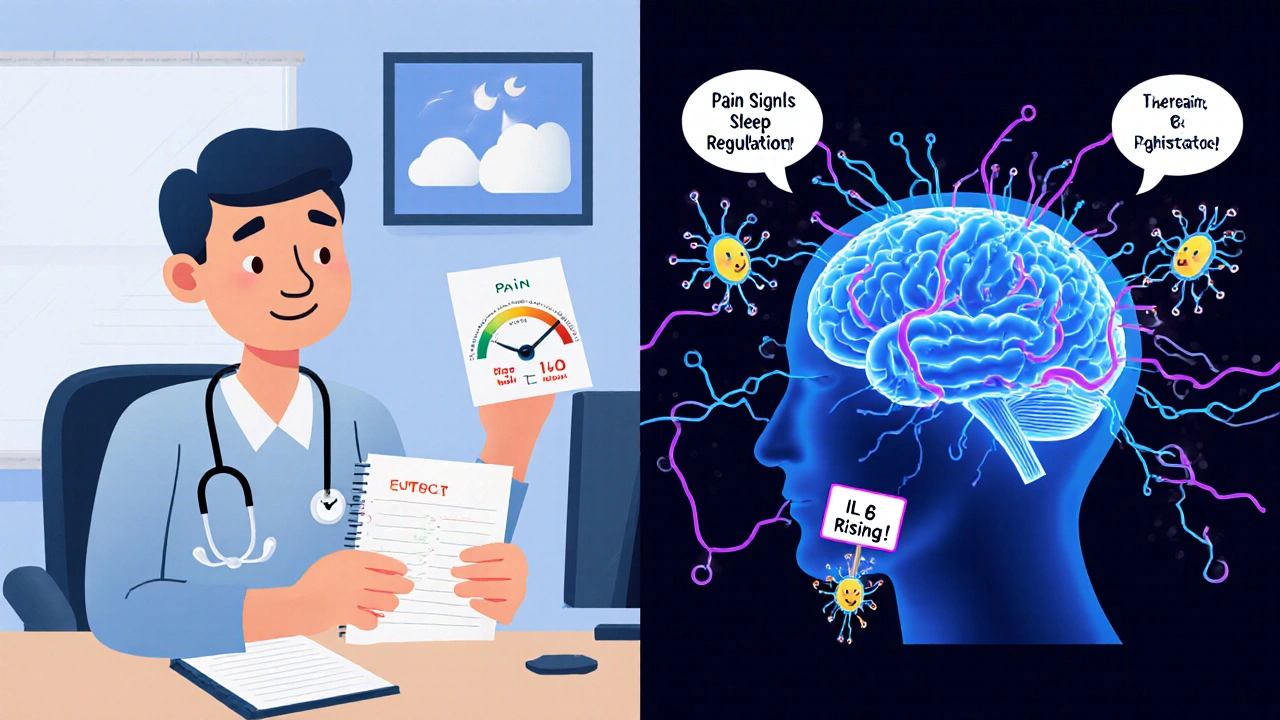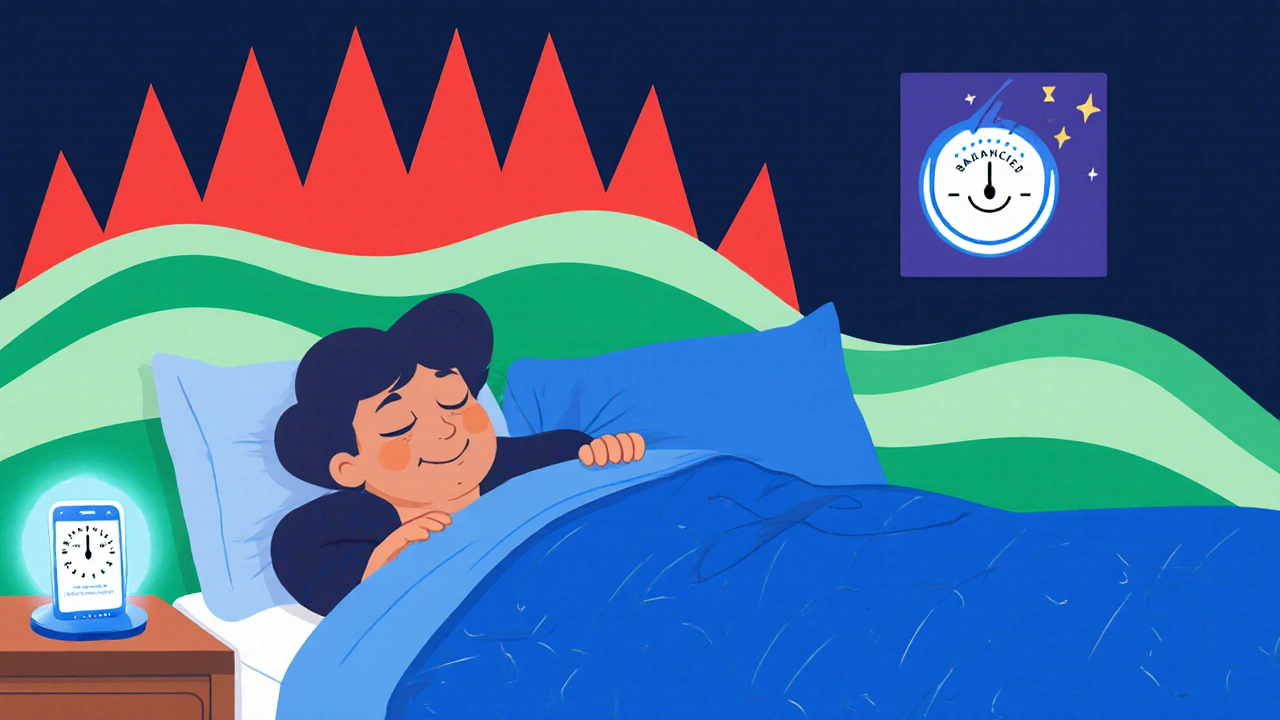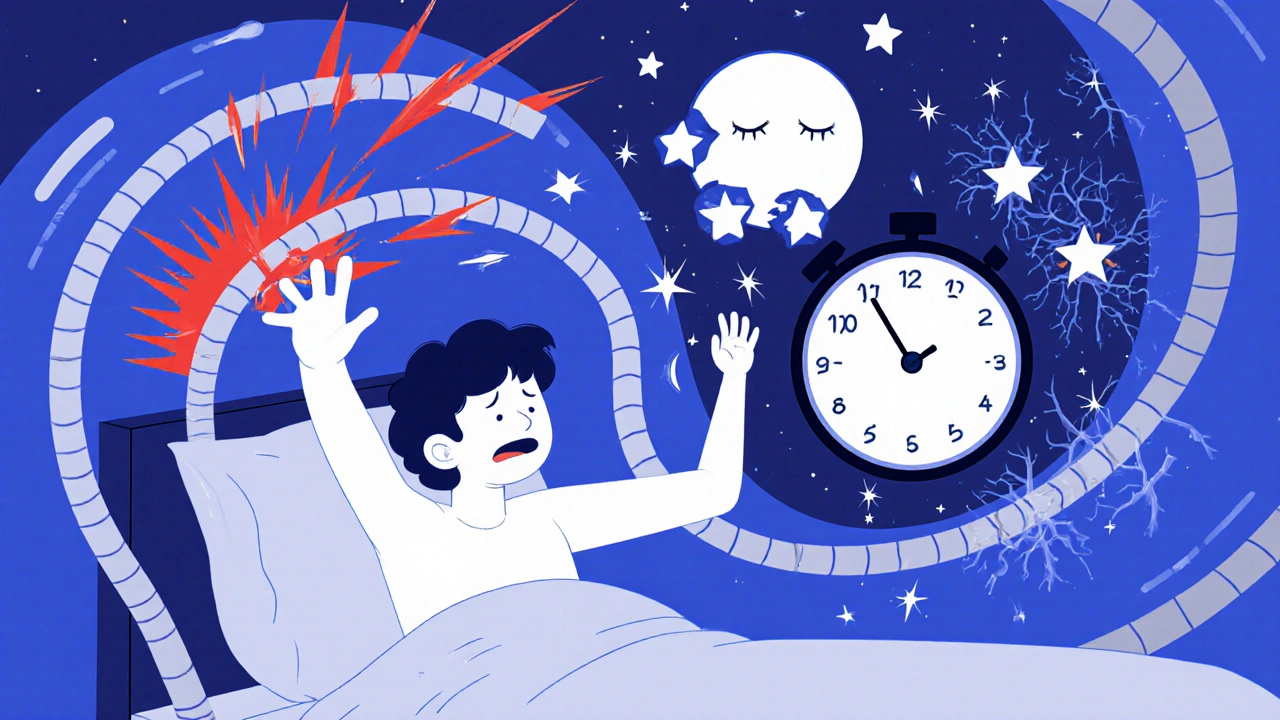When you’re in constant pain, falling asleep feels impossible. And when you finally do sleep, it’s restless, broken, shallow. The next day, your pain is worse. It’s not just bad luck-it’s a cycle. And it’s happening to millions of people right now. Chronic pain doesn’t just keep you awake; it rewires your brain to feel more pain when you’re tired. At the same time, not sleeping enough makes your body more sensitive to pain. It’s a loop. And unless you break it, you’ll keep spinning in it-night after night, pain after pain.
The Cycle Is Real, and It’s Measurable
People with chronic pain don’t just have trouble sleeping-they have insomnia. Studies show that between 50% and 80% of those living with long-term pain report sleep problems severe enough to meet clinical criteria for insomnia disorder. That’s more than half. Compare that to the general population, where only about 10-15% have insomnia. The numbers don’t lie: if you’re in pain, sleep is likely one of your biggest struggles.
But here’s what most people don’t realize: it’s not just pain keeping you up. Poor sleep is also making your pain worse. In controlled studies, healthy people who were sleep-deprived showed a 10-20% drop in pain tolerance. Their brains started registering mild pressure as sharp pain. For someone already dealing with arthritis, fibromyalgia, or back injuries, that’s like turning up the volume on a speaker that’s already blasting. One night of bad sleep can make your pain spike from a 4/10 to an 8/10. And it can take days to recover.
Objective data backs this up. People with chronic pain take 25-30 minutes longer to fall asleep. They wake up 40-50% more often during the night-averaging over an hour of wakefulness. Their total sleep time drops to around 6.2 hours, compared to 7.1 for healthy adults. Sleep efficiency-the percentage of time in bed actually spent sleeping-plummets by 8-10%. And their Pittsburgh Sleep Quality Index scores? Around 10.5, compared to 5.2 in people without pain. That’s not just poor sleep. That’s clinical insomnia.
What’s Happening in Your Brain
This isn’t just about discomfort. It’s biology. Your brain has built-in pain control systems-like a natural painkiller factory. They rely on chemicals like endogenous opioids, dopamine, and melatonin. But when you don’t sleep, these systems shut down. Research shows sleep loss reduces your body’s natural opioids by 30-40%. That’s like turning off your own pain relief.
At the same time, your brain’s pain alarm system gets louder. Inflammatory signals like IL-6 rise by 25-35%. Nitric oxide and adenosine-both linked to pain signaling-go into overdrive. And dopamine, the chemical that helps you feel calm and in control, drops by 20-30% after just one night of poor sleep. That’s why you feel more anxious, more irritable, and more sensitive to pain the next day.
Scientists at Massachusetts General Hospital found a specific neural loop that locks pain and sleep deprivation together. It’s like a thermostat stuck on “high.” Even when the pain stimulus doesn’t change, your brain interprets it as worse because your sleep is broken. Dr. Shiqian Shen, who led the research, compares it to a room that feels freezing even when the temperature hasn’t changed-because the thermostat is broken.
Another key player? Kappa opioid receptors. These are special receptors in the brain that help regulate both pain and sleep. Researchers at the University of Arizona found that targeting these receptors in animal models improved sleep quality by 40-60%. That’s a breakthrough. It means future drugs could treat both pain and insomnia at the same time-not just one or the other.
Why Pain-Only Treatment Fails
Most doctors treat pain first. They prescribe painkillers, physical therapy, injections. But if your sleep is still shattered, the pain comes right back. Patients who get pain treatment without sleep support report 35-45% higher pain intensity, 28% longer pain episodes, and 50% worse daily functioning than those who get sleep help too.
And here’s the kicker: in initial consultations, 78% of chronic pain patients say they want help with sleep more than they want help with pain. They’re not asking for stronger meds-they’re asking for rest. But most clinics still don’t screen for sleep problems. A 2018 survey showed only 35% of pain clinics routinely checked for insomnia. By 2023, that number jumped to 92%. Progress, yes-but far from universal.
Patients who get fragmented care often leave frustrated. Trustpilot reviews show that clinics offering integrated sleep-pain treatment get 4.7/5 ratings. Clinics that only treat pain? 3.2/5. The difference? One addresses the whole problem. The other treats a symptom.
And over-the-counter sleep aids? They rarely help long-term. The Arthritis Foundation found that 72% of chronic pain patients try them-but only 35% get lasting relief. And 42% say they feel groggy the next day, which makes their pain feel even worse. It’s a band-aid that makes the wound hurt more.

The Most Effective Fix: CBT-I
There’s one treatment that works better than any pill, patch, or injection for breaking this cycle: Cognitive Behavioral Therapy for Insomnia, or CBT-I.
CBT-I isn’t about sleeping pills. It’s about rewiring your brain’s relationship with sleep. It teaches you how to associate your bed with rest-not stress. It helps you let go of the fear of not sleeping. It resets your internal clock. And it works.
Studies show that after 8-10 weekly sessions with a certified CBT-I therapist, 65-75% of chronic pain patients see major improvements in sleep. And here’s the surprise: 30-40% also report less pain. Not because the injury changed-but because their brain stopped overreacting to it.
One patient, Sarah M., described it this way: “After four nights of bad sleep, my fibromyalgia flares go from a 4/10 to an 8/10. It takes me two weeks to recover-even after I sleep better.” That’s the cycle. But after doing CBT-I, she went from 45 minutes to fall asleep to 15. Her wake-ups dropped from 70 minutes a night to 20. And her pain? Down 30%.
CBT-I improves sleep efficiency by 12-15 percentage points. It cuts sleep onset latency by 25-30 minutes. It reduces nighttime awakenings by 35-40 minutes. These aren’t small gains. These are life-changing.
And you don’t need to see a therapist in person. Digital platforms like Sleepio have shown 60-65% effectiveness in chronic pain patients. The catch? Completion rates are lower-only 55% stick with it. That’s because it takes effort. You have to track your sleep, change your habits, and sit with discomfort. But the payoff? Lasting.
How to Start Breaking the Cycle Today
You don’t need to wait for a specialist. Start here:
- Track your sleep and pain for two weeks. Use a simple journal. Note: when you got into bed, how long it took to fall asleep, how many times you woke up, total sleep time, and your pain level on a scale of 1-10 the next morning.
- Use the Insomnia Severity Index (ISI). It’s a free 7-question test. If your score is above 15, you have clinically significant insomnia. That’s your signal to act.
- Stop lying in bed awake. If you’re not asleep in 20 minutes, get up. Go to another room. Read under dim light. Don’t check your phone. Come back only when you’re sleepy.
- Protect your sleep window. Go to bed and wake up at the same time every day-even on weekends. This is the single most powerful thing you can do to reset your internal clock.
- Avoid caffeine after 2 p.m. And no alcohol close to bedtime. It might make you drowsy, but it fragments your deep sleep.
- Try a CBT-I app. Sleepio, Somryst, or the NHS-recommended Sleepio program are proven tools. They’re not magic-but they’re the closest thing we have to a cure.

What’s Coming Next
The science is moving fast. The NIH spent $12.7 million in 2023 alone on research into the pain-sleep cycle. There are 47 active clinical trials right now. One drug targeting kappa opioid receptors is heading toward FDA Fast Track approval. It could be available by 2026.
Researchers at MGH have identified 12 gene variants that link pain sensitivity and sleep regulation. In the future, you might get a genetic test that tells you whether CBT-I or a new drug will work better for you.
The market for integrated pain-sleep treatments is projected to hit $5.7 billion by 2028. That’s not just business-it’s recognition. The medical world is finally catching up to what patients have known all along: you can’t treat pain without treating sleep.
You’re Not Broken
If you’re caught in this cycle, it’s not your fault. You’re not lazy. You’re not failing. Your brain and body are stuck in a loop that biology built. But biology can be rewired.
Breaking the pain-sleep cycle isn’t about finding the perfect mattress or the strongest painkiller. It’s about changing how your brain responds to pain when it’s tired. And that change is possible. With the right tools, the right support, and the right patience-you can start sleeping again. And when you do, your pain won’t just feel better. It will actually get less.
Can poor sleep cause chronic pain, or is it just a symptom?
Poor sleep doesn’t just worsen existing pain-it can actually cause it. Studies show people with sleep problems but no prior pain have a 56% higher risk of developing chronic pain within five years. Sleep loss lowers your pain threshold and increases inflammation, turning normal sensations into pain signals. It’s not just a side effect-it’s a root driver.
Is CBT-I effective for people with severe pain?
Yes. CBT-I works even for severe chronic pain. Research shows 65-75% of patients with conditions like fibromyalgia, arthritis, or back pain see major improvements in sleep after CBT-I. And 30-40% report reduced pain intensity-not because their injury changed, but because their brain stopped overreacting to pain signals when tired.
Why don’t doctors always talk about sleep when treating pain?
Historically, sleep was seen as a secondary issue. But that’s changing. By 2023, 92% of pain clinics started screening for insomnia-up from 35% in 2018. Still, many providers aren’t trained in sleep medicine. If your doctor doesn’t ask about sleep, ask them. It’s a critical part of pain management.
Can pain medications help me sleep better?
Most pain meds don’t improve sleep quality-and some make it worse. Opioids reduce deep sleep. NSAIDs can cause nighttime awakenings. Even muscle relaxants often leave you groggy the next day, which can increase pain sensitivity. Sleep aids like melatonin or antihistamines offer only short-term relief. They don’t fix the root problem: your brain’s sleep-pain loop.
How long does it take to break the cycle?
Most people see sleep improvements within 2-4 weeks of starting CBT-I. Pain reduction often follows within 6-8 weeks. But full cycle-breaking takes time. It’s not a quick fix-it’s a rewiring process. Stick with it. Even small improvements in sleep-like cutting nighttime awakenings from 60 to 30 minutes-can lead to big drops in pain over time.
Are there any new drugs on the horizon for this cycle?
Yes. A new class of drugs targeting kappa opioid receptors is in phase 2 trials and expected to enter phase 3 by late 2024. These drugs aim to improve both sleep and pain simultaneously. Early results show 30-35% improvement in sleep quality and 25-30% reduction in pain scores. If approved, they could be available by 2026.
 Nov, 17 2025
Nov, 17 2025
